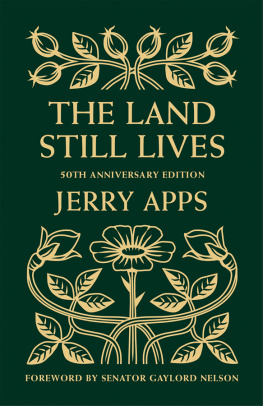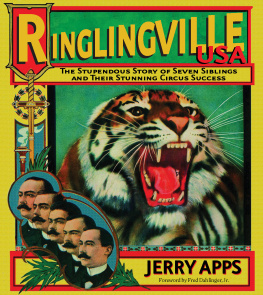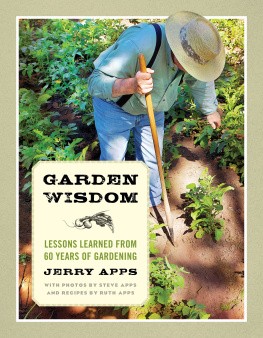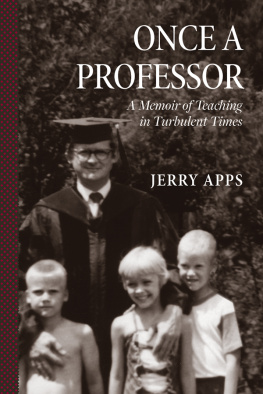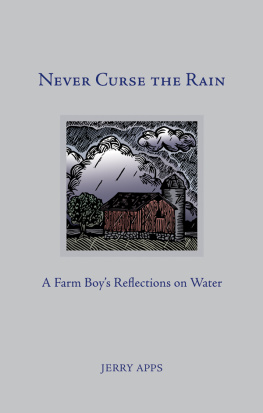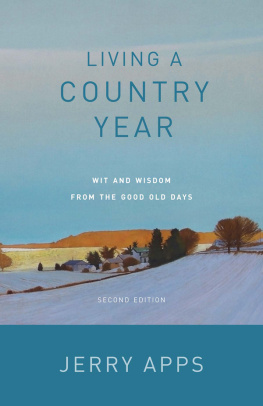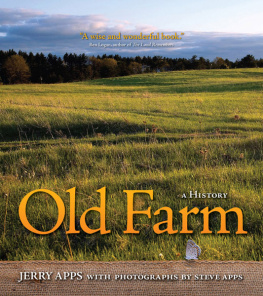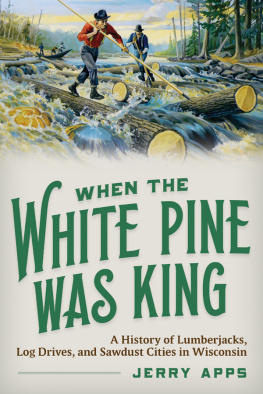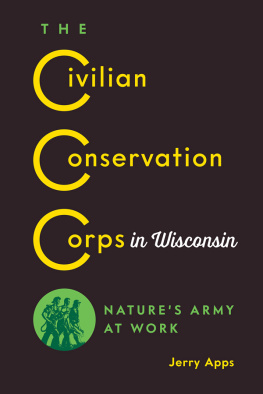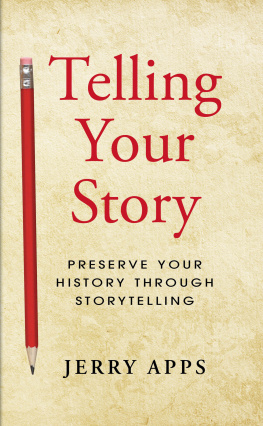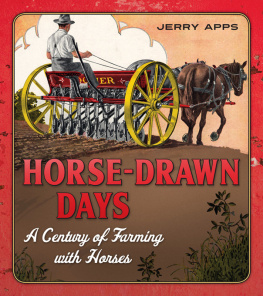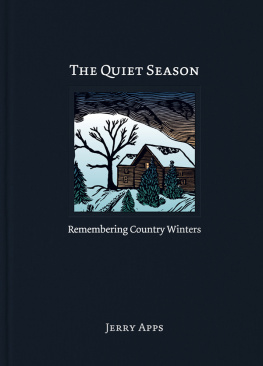THE LAND
STILL LIVES
THE LAND
STILL LIVES
JERRY APPS
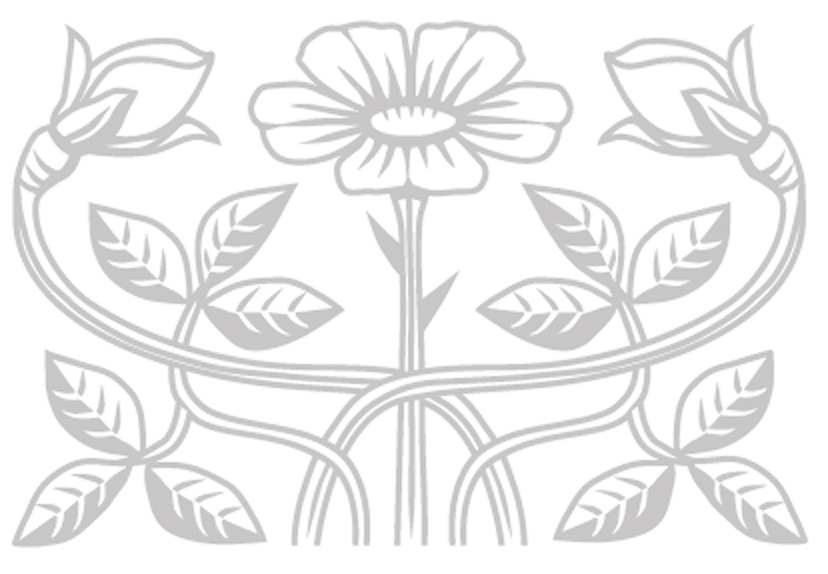
FOREWORD BY
SENATOR GAYLORD NELSON
WISCONSIN HISTORICAL SOCIETY PRESS
Published by the Wisconsin Historical Society Press
Publishers since 1855
The Wisconsin Historical Society helps people connect to the past by collecting, preserving, and sharing stories. Founded in 1846, the Society is one of the nations finest historical institutions.
Join the Wisconsin Historical Society: wisconsinhistory.org/membership
2019 by Jerold W. Apps
E-book edition 2019
First edition published 1970 by Wisconsin House, Ltd.
Wisconsin Historical Society Press edition published 2019
For permission to reuse material from The Land Still Lives (ISBN 978-0-87020-906-2; e-book ISBN 978-0-87020-907-9), please access www.copyright.com or contact the Copyright Clearance Center, Inc. (CCC), 222 Rosewood Drive, Danvers, MA 01923, 978-750-8400.
CCC is a not-for-profit organization that provides licenses and registration for a variety of users.
Designed by Nancy Warnecke, Moonlit Ink
23 22 21 20 19 1 2 3 4 5
Library of Congress Cataloging-in-Publication Data
Names: Apps, Jerold W., 1934- author.
Title: The land still lives / Jerry Apps ; foreword by Senator Gaylord Nelson. Description: Fiftieth anniversary edition. | Madison, WI: Wisconsin Historical Society Press, 2019. | First edition published 1970 by Wisconsin House, Ltd.
Identifiers: LCCN 2019009252| ISBN 9780870209062 (hardcover : alk. paper) | ISBN 9780870209079 (e-book)
Subjects: LCSH: Farm lifeWisconsin. | Country lifeWisconsin.
Classification: LCC S521.5.W6 A66 2019 | DDC 630.9775dc23 LC record available at https://lccn.loc.gov/2019009252
For Sue, Steve, and Jeff,
who one day will inherit Roshara
ACKNOWLEDGMENTS
I am indebted to Mrs. Charlotte Stewart and her brother, Weston Coombes, for relating to me their memories of Roshara.
My father and mother, Mr. and Mrs. Herman Apps, who well recall their childhood in the Chain O Lake-Skunks Hollow community, were the source of many facts related throughout this book.
Jennie Woodward of the Wild Rose Historical Society and her brother, Sherm Woodward, provided information about Wild Rose during the potato boom days of the early 1900s.
I hold a deep feeling in my heart for Floyd Jeffers, now deceased, who told me much about our Roshara and the people who lived there. I shall never forget his deep understanding of the outdoors and of the legacy of the land.
I must thank Howard Sanstadt, Barbara Vroman, and Arlene Buttles of the Waushara Argus staff, who constantly encouraged me in my writing about the outdoors.
My wife, Ruth, participated in every part of our Roshara adventure. She also read, reread, and helped correct the manuscript. I owe her heartfelt thanks.
And, finally, special thanks to Robert Gard for constant encouragement and creative suggestions.
CONTENTS
Jerry Apps has written a story which, as he says, has no end. Its beginning is as old as the earth itself. It is a story of life of the land and of one family that returned to it in search of a certain missing quality.
Apps is a man of ideas who is sensitive to the touch, the smells, and the feel of doing things by hand, today and a hundred years ago.
He talks of a purity and a simplicity of existence that, for most of us, is lost forever. The lush green hills and the lone-standing farms are disappearing under cities and ribbons of asphalt as we jostle together and every year find less room to breathe.
Perhaps we cannot return to the Apps cabin at Roshara, or to Thoreaus Walden, but we can affirm our own reverence for the land by doing something to protect it.
Today, the crisis of the environment is the biggest challenge facing mankind. To meet it will call for reshaping our values, to put quality on a par with quantity as a goal of American life.
It will require sweeping changes in our institutions, national standards for the goods we produce, a humanizing of our technology, and close attention to the problem of our expanding population.
Most of all, it will require that the people assert their right to a decent environment and that they evolve an ecological ethic of understanding and respect for the bonds between man and his planet.
Apps and his family have joined in an experience which ultimately must become the experience of us all. That is to realize that living is now, more than ever before, a matter of getting along with the environment in which we live, because our planet earth is the only known body capable of supporting life as we know it. If we ignore this fact, we diminish life for all living things and face the real possibility of our eventual destruction.
Senator Gaylord Nelson
1970
The old black willow at the end of the windbreak is really six trees in one, but since two of the trunks have broken, only four fingers point skyward. The top of one broken trunk touches the ground, dead, smashed in a windstorm. The other trunk broke off three years ago and was removed. In the dead stub that remains, woodpeckers have pounded pencil-sized holes every few inches in search of insects living under the dead bark. From dead branches on the other trunks some of the bark has fallen off, exposing the furrows made by insects. To some, the old willow is shaggy and disheveled. Perhaps. But the shagginess gives the tree its character, makes it something more than other trees, makes it different from the ten-foot white pine that grows nearby with soft needles and organized placement of branches.
The old willow is surely not organized; branches shoot out from its trunks in all directions. Some are last springs growth and olive green in color, some are several years old and already have furrowed bark, and some are dead with no bark at all.
A few years ago, lightning ripped away a strip of bark from the top to the ground, leaving a twisted wound in one trunk.
The end willow, as we call this magnificent old tree, grows at Roshara, our country farm in Waushara County, Wisconsin. The farm is one hundred miles north of Madison, where my family and I live, and five miles west of Wild Rose, our nearest village. Wautoma, the county seat, is ten miles to the south.
The community around Roshara is called Skunks Hollow, no doubt for the many skunks denning there when the area was settled. The nearby community of Slab City is named for a local sawmill, long since closed down and moved.
The whole larger community, including Slab City and Skunks Hollow, is called Chain O Lake. It is the name originally given to the country school that, when it operated, lay a mile from Roshara. There are many small lakes and ponds in the region, and though they are not connected, the local folks think of them as a chain.
Roshara is an abandoned farm; no crops grown there now, no livestock. The farm buildings, once housing Guernsey cattle, pigs, and horses, are gone except for the granary we are making into a cabin and the old pump house that squats over the well.
The hundred acres of fields and woods rest quietly, but standing under the old end willow I can close my eyes and envision the corn and potatoes that once grew in the fields and the cattle that grazed in the pasture near the pond.
The remnants of farming days whet my imagination. Old fences remain partially standing, partially buried by grass, and they help me to picture the cattle in the fields. Four gnarled apple trees and several plum trees suggest an earlier orchard capable of keeping the families at Roshara supplied with fresh fruit.

